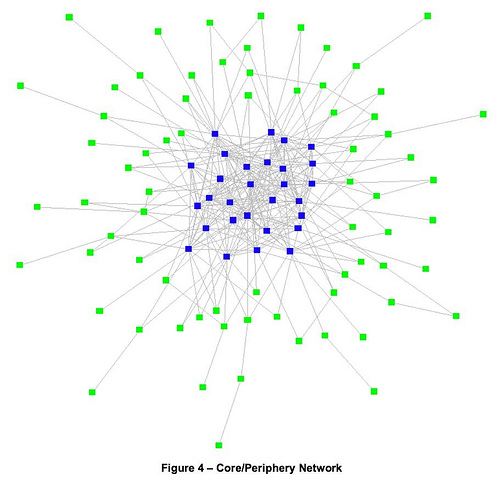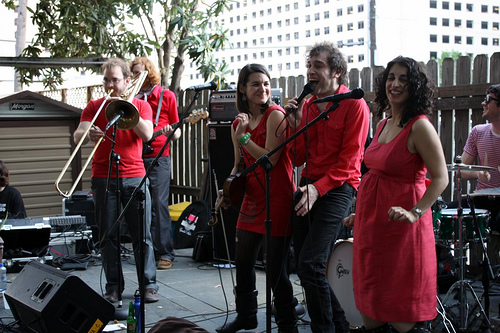All this talk about ‘developing a network’ and ‘organizational change for the connected age’ can feel both daunting and vague. But really, it’s just like starting a band! (And you’ve always wanted to be a rock star, right?) Here’s how it works in five easy steps.
- If you don’t already have a band/network, what kind do you want to start? Ah, the all-important question of purpose; the question we so often avoid (or forget, or ignore). Whether you’re starting a band or a network, you’ve gotta know why. For a band, the goal may be to have the equivalent of a Saturday night poker club, or it may be to spread a particular message, or it may be to hit the Top 40 and win a Grammy or two. Whatever it is, the whole band has got to be on the same page in order to meet that goal. For a network, what is the change you are trying to make in the world? It may be to push through a particular piece of legislation, to revitalize a neighborhood, or to overhaul an entire educational system. The answer to this question – ultimately a question of your communal DNA – will have bearing on all the other questions you’ll need to ask yourself moving forward. Look at your community; how would you define your communal DNA?
- What instruments/skills do you need to make the music? Who do you already have, and who do you need? (And does everyone know their role?) To answer this question, it’s important to reference tried-and-true templates, but also to think outside the box and be open to serendipity. A rock band may typically be drums, guitar, bass, and vocals, but magic can happen when you throw in an electric violin or, dare I say it, an accordion. A network focused on housing issues needs governmental connections, lawyers, activists…but what happens when you engage those benefiting from the work of the organization? Or schools? Or artists? You may also want to ask what other skills folks bring to the table. It’s exciting – and useful – when you find out the saxophonist is also a graphic designer, or the artist in your network has a background in urban planning. What ‘instruments’ are already making music in your community?
(Photo credit: Flickr user ryry9379)
- How are the musicians/members going to work together? The logistical bit. Basically, what does band practice look like? How formal are your gatherings? What kind of space, physical and/or virtual, do you need? How often will you meet? Does everyone read sheet music or do you need to pair people up to teach one another the tunes? And, of course, how will performances (if you perform at all) be arranged? The same is true for networks. Some are like closeted chamber choirs who work diligently at their craft but are rarely seen in public, while others are punk bands who use gigs as rehearsal time. This is also the place to consider folks’ other obligations. Is the drummer the only one in town who can keep time and is playing weddings with other groups every weekend? If so, what does that mean for the band? Are there other organizational affiliations or time constraints among the members of your network you need to consider? What are your community’s priorities, and where is the overlap with your goals? How can other priorities be a challenge, and how are they an advantage?
- What other connections do you need in order to be successful? A danger in both bands and networks is that the core becomes too tight. The group only looks inward and becomes an echo chamber. This often doesn’t make for good (or, at least, popular) music because it doesn't produce what the audience really wants to hear, and never makes for a healthy network. Therefore, it’s important to develop what I call peripheral vision; the ability to see the edges of your network and bring in new ideas. Who’s at the edge of your network, and what role can they play? Or put another way, of the things you need, how much of that can you get from your close connections in your current network/band, and how much do you need to look for elsewhere (build new connections)? For a band, it might be fans, venues, other musicians, or social media marketers. For a network, these folks might be network strategists, thinkers in parallel fields, like-minded groups in other geographical areas, or folks from other faith traditions, ethnic backgrounds, or age cohorts. Take a peek out of the corner of your eye; who’s in your peripheral vision who can help your community make real change?

(Photo credit: Flickr user Ross Mayfield)
- Is it working? As always, ya gotta go back to your goal! Are you accomplishing what you set out to do? In order to know that, you have to think about how you can measure your success. As with all measurement, there are quantitative and qualitative approaches, and both are necessary. The quantitative element may have to do with how many people are hearing the music, or coming to shows, or whether people are sharing it with their friends, or which songs are getting the most airplay, etc. Qualitatively speaking, you want to think about other things. Does the music sound good, does it feel good? Are the personalities meshing and the communal DNA evolving? Are you making people dance? Is your song getting stuck in people’s heads? It’s the same with networks. Take a balcony view of the folks in your group. Are the right connections in place to make great things happen? Where can you leverage existing connections, and where can you work on building new ones? And, perhaps most importantly, who can help you make it even better?! No network weaver is an island, after all. How do you measure the health and effectiveness of your community?
Regardless of whether you’re starting a community of practice for Jewish educators or the next great 80’s tribute band, these are a few crucial questions that will help make the whole enterprise sing.
What are the other key ingredients? What else has made your network (or band!) successful?
Many thanks to my bandmate and husband, Alan Sufrin, for being awesome and helping me think through this post.
This post is part of a blog series on Connected Congregations being curated by Darim Online in partnership with UJA Federation of New York. Through this series, we are exploring what it means for synagogues to function as truly networked nonprofits. Connected Congregations focus on strengthening relationships, building community, and supporting self-organizing and organic leadership. They are flatter and more nimble, measure their effectiveness in new and more nuanced ways, allocate their resources differently, and use technology in a seamless and integrated way to support their mission and goals. We hope these posts will be the launching pad for important conversations in our community. Please comment on this post, and read and comment on others in the series to share your perspective, ideas, work and questions. Thanks to UJA Federation of New York for supporting this work.



 Yoni Sarason is the Midwest Regional Director at NEXT: A Division of Birthright Israel Foundation. For ideas about how to implement some of these ideas in your community, you can reach Yoni at
Yoni Sarason is the Midwest Regional Director at NEXT: A Division of Birthright Israel Foundation. For ideas about how to implement some of these ideas in your community, you can reach Yoni at 